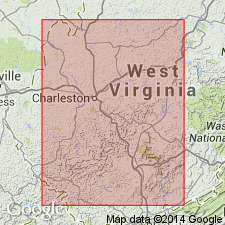
- Usage in publication:
-
- Kanawha formation*
- Modifications:
-
- Named
- Dominant lithology:
-
- Shale
- Coal
- Sandstone
- AAPG geologic province:
-
- Appalachian basin
Summary:
Named Kanawha formation for Kanawha Falls, WV. Consists of great mass of coals, shales, and sandstones, 1150 to 1200 feet thick. Unit underlies the Charleston sandstone and overlies the Fayette sandstone. It includes the Kanawha black flint at the top. The Kanawha is of Pennsylvanian age.
Source: GNU records (USGS DDS-6; Reston GNULEX).
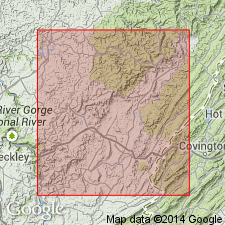
- Usage in publication:
-
- Kanawha group
- Modifications:
-
- Revised
- AAPG geologic province:
-
- Appalachian basin
Summary:
Revised the Kanawha to the Kanawha group in WV. Group comprises the upper part of the Pottsville series and is the youngest group of stratified rocks in Greenbrier Co., WV. The maximum thickness of the Kanawha group in 250 feet and it overlies the New River group.
Source: GNU records (USGS DDS-6; Reston GNULEX).

- Usage in publication:
-
- Kanawha formation*
- Modifications:
-
- Biostratigraphic dating
- AAPG geologic province:
-
- Appalachian basin
Summary:
The age of the Kanawha formation is Middle Pennsylvanian based on fossil plants.
Source: GNU records (USGS DDS-6; Reston GNULEX).
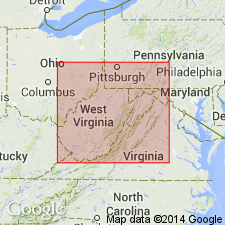
- Usage in publication:
-
- Kanawha Formation
- Modifications:
-
- Overview
- AAPG geologic province:
-
- Appalachian basin
Summary:
The Kanawha Formation in WV includes (ascending) the Homewood Sandstone [Member], and the Stockton (Mercer), Coalburg, Winifrede, Chilton, Williamson, Cedar Grove, Peerless, Campbell Creek, Powellton, Eagle, Gilbert, and Douglas coal beds.
Source: GNU records (USGS DDS-6; Reston GNULEX).
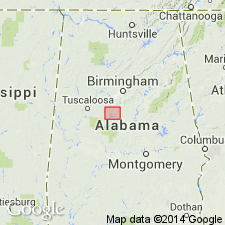
- Usage in publication:
-
- Kanawha Group
- Modifications:
-
- Areal extent
- AAPG geologic province:
-
- Appalachian basin
Summary:
The Kanawha Group is geographically extended to central AL. Unit includes (ascending) the Montevallo, Dogwood, and Maylene coal beds.
Source: GNU records (USGS DDS-6; Reston GNULEX).
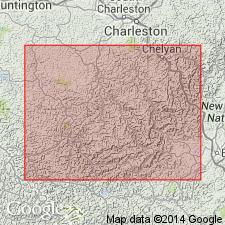
- Usage in publication:
-
- Kanawha Formation*
- Modifications:
-
- Revised
- AAPG geologic province:
-
- Appalachian basin
Summary:
Kanawha Formation in WV is composed of coal-bearing sequences of sandstones, siltstones, and shales. Historically, Kanawha has been subdivided by key coal beds of regional extent, as well as by locally persistent sandstones, fossiliferous shales, and marine limestones. In county geologic reports and maps published between 1906 and 1939, authors adapted and modified the stratigraphic nomenclature to suit their own individual needs; because subdivision of the Kanawha depended on presence of coal beds, the county reports are inconsistent one with the other. More recent work in WV and KY indicates that marine limestone and shale units are more easily identified and extensive throughout the region, but even they have been misidentified and given more than one name. On the basis of their regional distribution, three marine units in the Kanawha are recognized as key elements in the Middle Pennsylvanian stratigraphic framework; they are (oldest to youngest): Betsie Shale Member (Rice and others, 1987), Dingess Shale Member (formalized and redefined here), and Winifrede Shale Member (formalized and redefined here). Correlation with Breathitt Formation in KY and historical usage of subdivisions of Kanawha and Breathitt discussed and shown in detail on figure 2. Report includes correlation charts and columnar sections.
Source: GNU records (USGS DDS-6; Reston GNULEX).
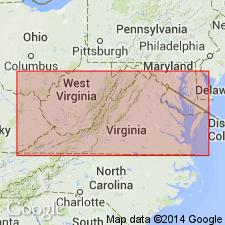
- Usage in publication:
-
- Kanawha Formation
- Modifications:
-
- Areal extent
- Overview
- AAPG geologic province:
-
- Appalachian basin
Summary:
The Kanawha is restricted to the eastern part of Buchanan and northern Russell Cos. The formation has a maximum preserved thickness of about 550 ft. Consists predominantly of gray shale, but sandstones are prominent locally with thicknesses ranging from less than 1 ft to as much as 130 ft. Formation is characterized by coals of great extent. They include the Kennedy, Bearwallow, Big Fork, Lower Banner, Upper Banner, and Splash Dam. Three traceable sandstone members are present: the Chicken Ridge Sandstone Member, the Bearwallow Sandstone Member, and an extensive unnamed sandstone below the Splash Dam coal bed. Unit conformably overlies the New River Formation and interfingers with the Norton Formation to the northwest.
Source: GNU records (USGS DDS-6; Reston GNULEX).
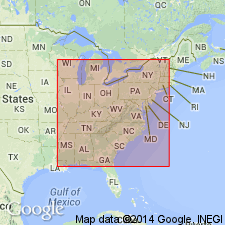
- Usage in publication:
-
- Kanawha Formation*
- Modifications:
-
- Areal extent
- AAPG geologic province:
-
- Appalachian basin
Summary:
Kanawha Formation is used only in WV and VA. Includes strata from base of Lower Douglas coal to top of Kanawha black flint of White (1891). Includes Betsie Shale Member, Dingess Shale Member, and Winifrede Shale Member in WV, and Bearwallow Sandstone Member and Chicken Ridge Sandstone Member in VA.
Source: GNU records (USGS DDS-6; Reston GNULEX).
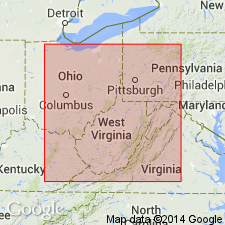
- Usage in publication:
-
- Kanawha Formation*
- Modifications:
-
- Overview
- AAPG geologic province:
-
- Appalachian basin
Summary:
Kanawha black flint (informal) of Kanawha Formation in WV correlates with Kilgore Flint Member and informal Flint Ridge flint of Morse (1931) of Breathitt Formation in eastern KY, and with Putnam Hill Limestone Member of Allegheny Formation in central OH.
Source: GNU records (USGS DDS-6; Reston GNULEX).
For more information, please contact Nancy Stamm, Geologic Names Committee Secretary.
Asterisk (*) indicates published by U.S. Geological Survey authors.
"No current usage" (†) implies that a name has been abandoned or has fallen into disuse. Former usage and, if known, replacement name given in parentheses ( ).
Slash (/) indicates name conflicts with nomenclatural guidelines (CSN, 1933; ACSN, 1961, 1970; NACSN, 1983, 2005, 2021). May be explained within brackets ([ ]).

